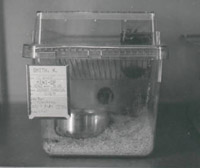Kathleen Smith's Lab
For many years, the Smith lab maintained a breeding colony of gray short-tailed opossums, Monodelphis domestica (Marsupialia: Didelphidae). We no longer have animals.
These animals are native to the South American countries of Brazil and Bolivia, and lab colonies are increasingly common. M. domestica are typically grayish-brown in color, and like many smaller marsupials, are pouchless. Males in our colony weighed between 105 and 125 grams while females tended to be a bit smaller, between 75 and 90 grams. The opossum's natural diet is composed largely of insects; our colony was fed "fox food" supplemented weekly with fruit and/or mealworms.
For normal housing, standard rat cages are suitable, and the animals should be provided with a food bowl, nesting house, nesting material (shredded paper), and a water bottle. Smaller animals are quite the escape artists, so tight fitting lids are a necessity. We kept the animals on a 12 hour light/dark schedule and maintained a temperature of about 74 degrees F with an ideal humidity between 50 and 60%.
 The gestation period of Monodelphis is about 14.5 days (after mating) and neonates begin to detach from the teat at about 2 weeks. At about 30-35 days the young develop independence -- their eyes open, they begin to locomote actively independently and they are capable of hearing. They are weaned at about 50-60 days and sexually mature at 5-6 months. A staging series for Monodelphis embryos may be found by clicking on the link on the right.
The gestation period of Monodelphis is about 14.5 days (after mating) and neonates begin to detach from the teat at about 2 weeks. At about 30-35 days the young develop independence -- their eyes open, they begin to locomote actively independently and they are capable of hearing. They are weaned at about 50-60 days and sexually mature at 5-6 months. A staging series for Monodelphis embryos may be found by clicking on the link on the right.
M. domestica are solitary in the wild and must be kept in indivdual cages except when breeding. When breeding, males and females must be introduced carefully, and injury, and even death of one of the two animals is common.
Our husbandry and laboratory protocols were published here:
Keyte, AL, and Smith, KK. (2008) "Opossum (Monodelphis domestica): A Marsupial Development Model. (Published online)" In: Emerging Model Organisms: A laboratory manual. Cold Spring Harbor Press, Cold Spring Harbor, NY. Pp. 557-575 link (email for reprint)
An excellent overview of the biology of Monodelphis domestica may be found in T. E. Macrini, Monodelphis domestica. Mammalian Species, no. 760, pp. 1-8 (American Society of Mammalogists)
As cute as they are, we do not recommend Monodelphis as a household pet.

Research
- Possum page
- Images
- JP Hill collection

click here for important references on Monodelphis biology and husbandry.
Our husbandry and laboratory protocols were published here:
Keyte, AL, and Smith, KK. (2008) "Opossum (Monodelphis domestica): A Marsupial Development Model. (Published online)" In: Emerging Model Organisms: A laboratory manual. Cold Spring Harbor Press, Cold Spring Harbor, NY. Pp. 557-575 link (email for reprint)

